When we talk about the difference between SEO and SEM, we are actually talking about different methods of advertising.
SEO is sometimes used as an umbrella term for SEM, but SEM certainly refers to the paid advertising that is actually different. SEM is about getting traffic through paid advertising, and SEO is about getting, monitoring, and analyzing organic (unpaid) traffic patterns.
Table of Contents
What is the difference between SEO and SEM?

The main difference is that search engine optimization (SEO) focuses on optimizing the website to get traffic from organic search results. On the other hand, the goal of search engine marketing (SEM) is to gain traffic and visibility from organic and paid searches.
Put it another way:
Google search results are divided into two main categories: paid search results and organic search results.
SEO and SEM are actually two sides of the same coin, but they have very different functions and are related to different aspects of marketing. Sometimes these two words are used to refer to similar activities, which can be confusing to those of us who do not know about this world.
SEO v/s SEM: Points of Difference
So, what is the difference between search engine optimization (SEO) and search engine marketing (SEM)? How do the two relate and work together?
Any digital marketing professional must master these two conditions and understand their importance in the field of marketing.
Let’s go through the video below in order to understand the difference more clearly.
Read on to find out the role of SEO and SEM in the field of digital marketing today.
Let’s have a look between points of difference
SEO: The Main Features
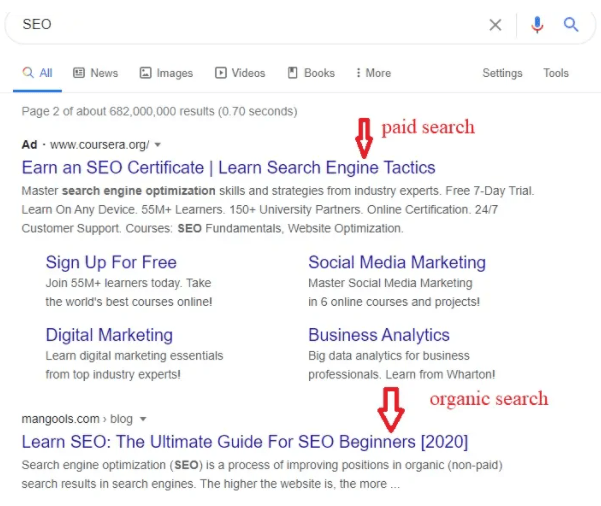
Google analyzes various aspects of how to rank web pages. It is important to optimize your website for SEO to get a top ranking.
SEO includes technical, on-page, and off-page search engine optimization.
On-page SEO
On-page SEO is the optimization of personal website pages and includes:
- The page content fits the search query.
- Clear, simple, and structured text.
- Key phrases in text, title, description, and H1-H6 tags.
- Detailed alt tags for images.
- Special content.
- Clear, concise, and readable URLs.
It is important that the text is not spammed with key phrases and that the text is monitored. If you do not follow these principles, your website may be filtered by a search filter (such as Panda or BERT on Google), an algorithm that reduces low-quality content delivery in search results. Is
On-page SEO provides results only with off-page optimization. Having accurate content does not mean that your website has a top ranking.
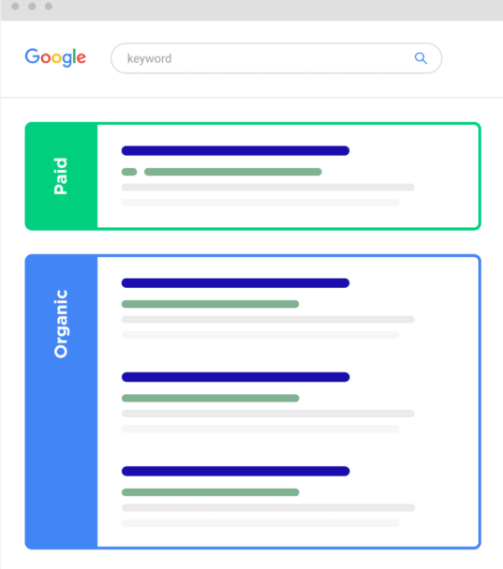
Off-page SEO
Off-page SEO is an off-site activity aimed at improving website rankings. These include:
- Quality backlinks.
- Creating and maintaining a Google My Business account.
- Positive review.
- Personal brand development.
With proper on-page and off-page SEO, a website gets a good ranking. Technology is also an important factor in SEO.
Technical SEO
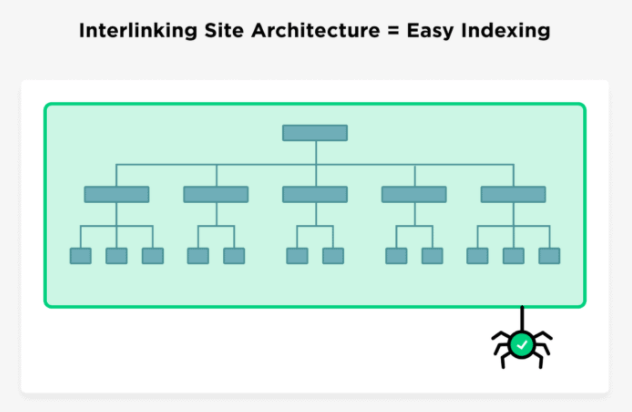
Technology SEO is aimed at technological changes that help search engines scan, evaluate, and index website content. Technical optimization includes:
- Setting up tags that point to search bots on your website
- Optimization of page load speed.
- Creating the latest Sitemap.xml
- Robots.txt file optimization.
- Facility for mobile UI.
- Server response code configuration.
Optimization of website internal links (follow / nofollow, index / noindex).
On-page, off-page, and technical SEO for your site - you can learn more about all aspects of search engine optimization in this post.
Some professionals who know all the basics of SEO make a big mistake. They do not have a comprehensive strategy. Strategy is a basic element in website promotion.
SEO strategy
Website promotion should start with a strategy. Plan and determine the steps you intend to take to improve your website ranking. Explore the best Keyword research tools for SEO
In general, the SEO strategy follows these steps:
- Audit your website (fix all errors).
- Create a semantic core.
- Analyze competitors.
- Create something new and different from your competitors.
- Write unique and relevant content.
- Off-page and technical SEO.
- Create external links.
- Update and add content.
SEM: The Main Features
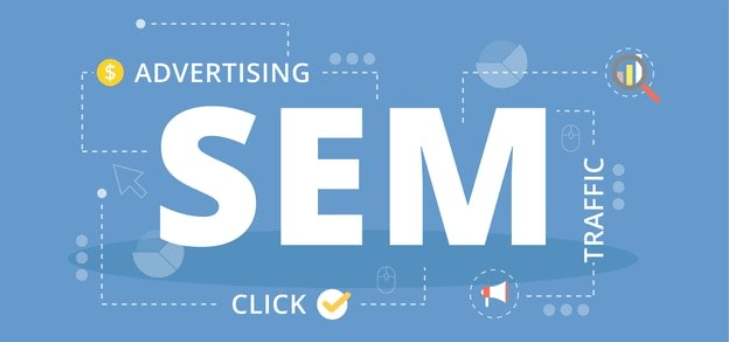
Search engine marketing (SEM) is a specific type of search marketing that is based on the display of paid websites in search results. SEM is keyword-based and includes SEO and PPC elements.
Various search engines use advertising services for SEM which includes the following features:
- Google Adwords on Google.
- Bing Ads on Bing.
- Find ads on Yahoo.
- Baidu statement in Baidu.
Depending on your area, target audience, and budget, you may choose one or more search engines for your business.
Like SEO, SEM requires a core strategy that will help you achieve the desired result. Let’s look at some important strategic features:
- Determine your target audience and area.
- Analyze the market and your competitors.
- Collect search queries.
- Analyze the list of selected questions and choose the one that is best for your business.
- Create an advertising campaign.
- Analyze advertising campaign and its optimization.
Social media also gives paid views. This should not be confused with SEM. Promotion through social media is called Social Media Marketing (SMM).
To choose a specific method of promotion, one must understand the similarities and differences between SEO and SEM.
Similarities between SEO and SEM
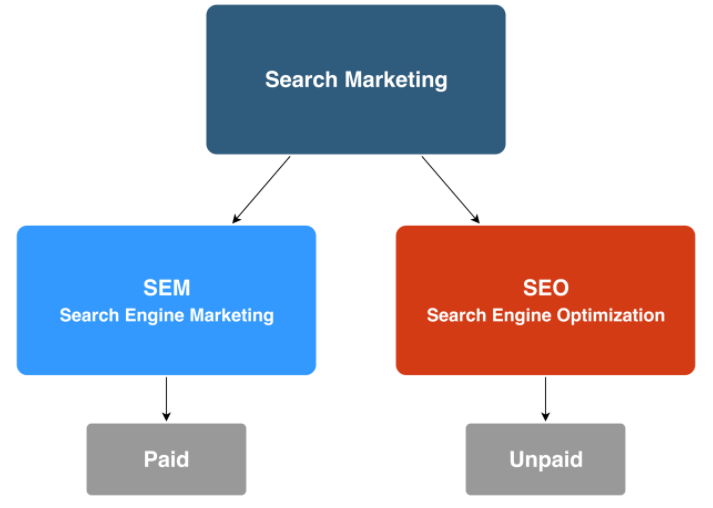
Although these words are different from each other, they are similar in some ways. Let’s take a look at these similarities.
- Improve the visibility of your website
- Drive relevant and quality traffic to your website
- Get a deeper understanding of your audience
- Use keyword research to increase traffic
- Requires ongoing customization
- SEO vs SEM: Which to use?
Now that you know the similarities and differences between the two words, let us understand when you use any strategy. To decide which to use, we must consider the following:
Specific goal
If your goal is to get traffic quickly or test a specific campaign, you can choose SEM/PPC. If your goal is long-term growth, you can choose SEM strategies.
Current performance
If your company already has good visibility, using SEM to increase this exposure and increase traffic is a good option.
Your margin
If your campaign costs are high and clicks are low, it makes no sense to continue investing in SEM without further evaluation and testing. In a situation like this, it would be more useful to use the best practices of SEO.
But, that means we want to use anyone strategy. Of course, using a combination of the two is even more beneficial because you can use insights from your SEM campaigns to improve your SEO performance. You can remarket your campaigns by making sure that keywords and other SEO methods are followed. Therefore, by combining the two efforts, you can achieve maximum effect and get a higher rank in the SERPs.
Advantages and Disadvantages of SEO
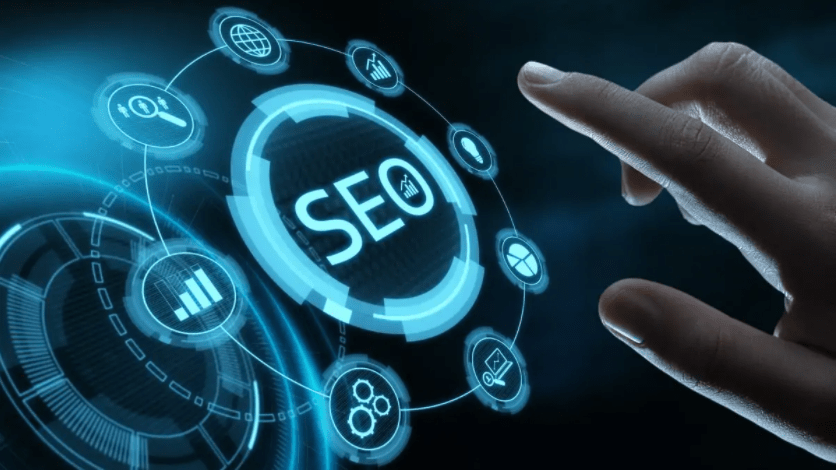
Before the advent of Google algorithms like Panda or Penguin, black SEO methods were popular. Today, it is not so easy. Google has greatly improved its ranking methods and now the success of promoting your business depends directly on the quality of your website. Let’s look at the main benefits of SEO:
1. SEO is cheaper than SEM. The cost of promotion does not depend on the number of clicks on the website. You do not have to pay for low-frequency queries, but they do give you extra traffic.
2. SEO provides a continuous traffic stream. Every day, users enter millions of questions online. By knowing the interests of your target audience, you can drive free targeted traffic to your website.
3. SEO can help you grow your business. Search engine optimization helps new brands become famous by bringing them into search rankings. The more important the questions on the front page of your website, the closer they will be to your audience.
4. It makes your brand visible. Even if you turn off SEO, your website will remain in good standing for a while. When SEM stops, the impressions stop and the brand stops appearing online. Without visibility, your customers will never find you.
5. SEO increases the credibility of your website. SEO helps your website appear in the top SERPs and earn credibility on Google. This will increase traffic and sales.
Long-term effect. With the right strategy and implementation, your website will stay on top for a long time. Even if you postpone your SEO campaign, your website will stay in the top spot for a while.
Despite the obvious advantages of SEO, there are also some disadvantages:
1. Promotion results take time. Typically, SEO takes three to six months before your website is topped. Your business is not always waiting that long.
2. Campaign results are difficult to predict. Due to frequent changes in the market, some products and services may not be relevant during the promotion.
3. You need to constantly update your content. Search engines focus on content v image and uniqueness. Therefore, you should focus on updating the website text to stay up to date.
4. Choosing the right strategy is difficult. Finding the right strategy or keywords that will enhance your website rank is a challenge.
5. Your website may come down in search results. When you re-optimize your website, you may be cut off from search filters, which can damage your rankings and reduce website traffic and sales.
Advantages and disadvantages of SEM
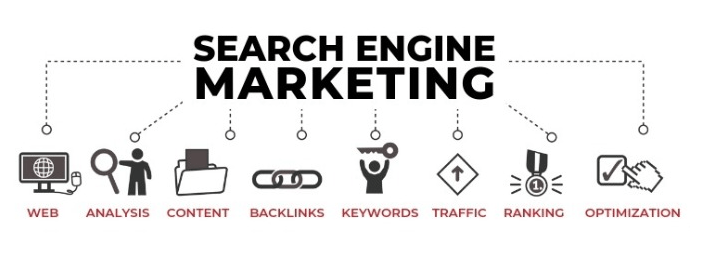
SEM is a paid advertising method. To use it you need to fully understand its advantages and disadvantages.
Advantages of SEM:
1. It expands the scope of the audience. You must pay exclusively for clicks on your ad, which will always appear on the first page of SERPs. You reach an audience that is available for a specific request.
2. Less chance of failure. With the right campaign layout, your ads will be relevant to search queries. Therefore, by visiting your website, the user will get the answer to their question and it will reduce the bounce rate.
3. Establishing brand identity. SEM allows you to appear on the first page of a search query. So, if you stop promoting through ads, the audience will already know when they find your website through search. Thus, the brand becomes recognizable, which helps in establishing your customer base.
4. Local small business development. You can set your ad for a specific geographical area, such as a small block. This will allow you to grow your business locally, which will benefit you.
5. Speed matters You do not have to wait 3 to 6 months to rank the first page. As soon as you start paying for the ad it will be displayed at the top of your website.
With all these SEM benefits, it is hard to believe that SEM has any disadvantages, but here they are:
1. It takes time to formulate a strategy. SEM is aimed at marketing and the marketer must take a long time to develop the right strategy.
2. Promotion can be expensive. Clicking on some search queries is expensive, but for SEO, switching from the same search query to a website is free.
3. High competition. PPC is an ongoing battle to deliver your ads. Competitors can use your text ad and further rank it by increasing the price per click. Their ads may be more relevant to user search queries and appear more than yours. Here, who pays more often takes up space.
Final Thoughts
Both SEM and SEO are equally important for an organization to achieve the desired results. In some cases, SEO may be the answer, and in other cases, SEM may be the solution. Sometimes, a combination of the two. Enroll in the Great Learning Strategic Digital Marketing Course and learn more similar concepts.
Before choosing SEO and SEM strategies and your promotion method you need to identify your budget and business goals.
SEO helps you get targeted traffic in the long run, and SEM attracts potential customers quickly. Still, it is better to use SEO and SEM together.
This means that first, you need to optimize your website, start promoting it and go for contextual ads. SEO and SEM together can drive incredibly targeted traffic and conversions for your business.
Hope! You find The above points of difference between SEO and SEM useful. Don’t forget to subscribe and leave comments. Thank You.

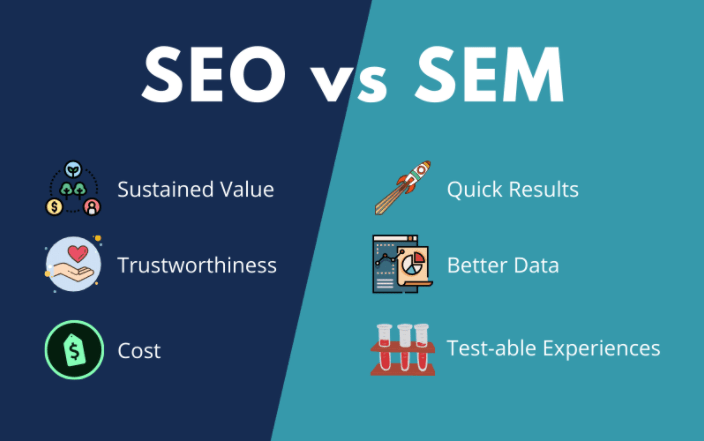



1 Comment